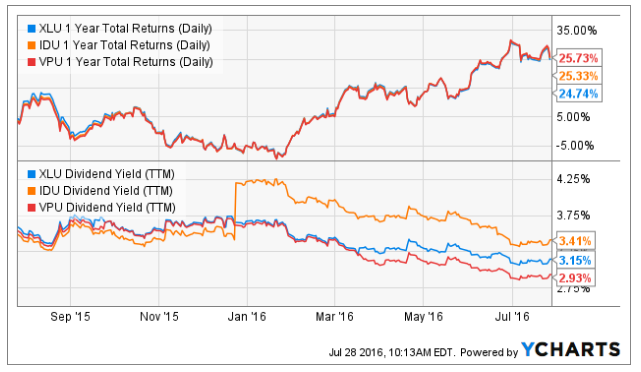Utilities are not a flashy industry that gets a lot of hype in the press. They simply trudge along, year after year, collecting reliable profits and growing earnings by a few percentage points each year. Their stocks pay hefty quarterly dividends to shareholders and grow them a little bit each year. But these are exactly the reasons utilities are so popular among income investors. For investors who desire income from their stock holdings, utilities are a gold mine because of their stability.
Their high dividends have become extremely attractive over the past year, due to the persistently low interest rate environment as the Federal Reserve has held off on raising interest rates this year. As a result, several prominent exchange-traded funds, or ETFs, have performed extremely well and have beaten the S&P 500 in the past 12 months.

Utilities SPDR ETF {% dividend XLU %}
Utilities SPDR ETF (XLU) is a highly popular ETF with $8.3 billion of net assets. Since its inception on December 16, 1998, XLU has returned 7.24% each year on average. It has a very low 0.14% expense ratio, and the fund is not very diversified, with just 30 holdings in the portfolio. However, it is diversified in terms of market capitalization. The fund holds large caps as well as midcaps and small caps. Its holdings range from a market cap as low as $4.6 billion, to as high as $59.2 billion. It predominantly holds stocks that are cheaper than the S&P 500 on a valuation basis. XLU has an average price-to-earnings multiple of 18.
The top three holdings include NextEra Energy (NEE ), with 9.15% of net assets, Duke Energy (DUK ) with 8.4%, and Southern Company (SO ) at 7.83%.
Going forward, XLU projects its holdings will deliver 3%-5% annual growth in earnings per share. When combined with its 3.1% dividend yield, it is reasonable to expect XLU can continue to provide returns at least on par with its historical average.
iShares U.S. Utilities {% dividend IDU %}
The iShares lineup of ETFs, which have become very popular in recent years, are issued by asset management firm BlackRock (BLK ). The IDU fund has been a strong performer over an extended period, returning 7.5% per year on average since inception. It provides exposure to the utility companies that supply electricity, gas, and water. The fund has net assets of $1.1 billion and 55 holdings in the portfolio.
As a whole, iShares U.S. Utilities (IDU) has a price-to-earnings ratio of 22 times. This is slightly above the valuation of the broader market but is in line with its peer group. In addition, IDU also has a dividend yield above the market average yield. IDU is a low-volatility fund, which is likely attractive to more conservative investors. It has a beta value of 0.31, which means for every 1% move in the S&P 500, IDU can be expected to move 0.31% in the same direction.
Similar to XLU, the top three holdings for IDU are NextEra Energy at 7.76% of assets, Duke Energy at 7.74%, and Southern at 6.69%.
Vanguard Utilities ETF {% dividend VPU %}
Vanguard is widely regarded as a champion for ETFs because its funds typically have among the lowest annual fees in the entire ETF universe. Vanguard Utilities ETF (VPU) is no exception. Its annual expense ratio is just 0.10% per year, which is lower than 91% of ETFs with similar holdings.
Since the fund’s inception on January 26, 2004, it has returned 10.67% per year. Currently, the fund holds 82 stocks, meaning it is highly diversified. It has total fund assets of $3.4 billion. While VPU is diversified in terms of number of holdings, it is at the same time highly concentrated among its largest holdings. The top 10 holdings make up nearly half the portfolio, at 49% of total assets. As with XLU and IDU, its top three holdings are NextEra, Duke, and Southern. Its sector breakdown is as follows: 57.6% in electric utilities, 29% in multi-utilities, 6.6% in gas utilities, 3.3% in water utilities, 2.8% in independent power producers and energy trading firms, and 0.7% in renewable electricity.
The Bottom Line
Exchange-traded funds, or ETFs as they are more commonly known, are a great way for investors to own a basket of securities in a specific industry or asset class. ETFs offer several advantages over the alternatives. For example, whereas mutual funds are priced once at the end of each trading day, ETFs are traded throughout the day and, as a result, have superior liquidity. ETFs also allow an investor to diversify their holdings by owning several stocks in a given category, which reduces single-stock risk.
Utilities have been among the market’s strongest performing sectors over the past year. XLU, IDU, and VPU are among the best utility ETFs that investors can buy.





